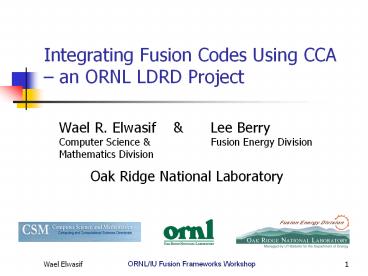Integrating Fusion Codes Using CCA PowerPoint PPT Presentation
1 / 22
Title: Integrating Fusion Codes Using CCA
1
Integrating Fusion Codes Using CCA an ORNL LDRD
Project
- Wael R. Elwasif Lee BerryComputer
Science Fusion Energy
DivisionMathematics Division - Oak Ridge National Laboratory
2
Project Goals
- Gain experience in using CCA components for
integrated plasma simulation. - Explore code integration issues
- Interface Development.
- Data Coupling.
- Have model sufficiently complex to understand
weaknesses/strengths of CCA. - But have it fit within a two year, 1.5 FTE/year
effort.
3
Project Members - Fusion
- Lee Berry
- Overall coordination, driver development,
integration, design. - Wayne Houlberg
- NTCC-like routines for calculations metrics from
eqdsk files, advancing ion densities, and
advancing electron and ion energy. - Fred Jaeger
- Implementations of AORSA and routines for brining
in equilibrium, plasma profiles into the form
needed for AORSA
4
Project Members Computer Science Mathematics
- Wael Elwasif
- Build system, CVS, implementation strategies
assistance, component infrastructure. - James Kohl
- State component, Visualization development.
- David Bernhardt
- CS coordination.
- Ed DAzevedo
- Development of iterative AORSA algorithm.
5
Prototype Components
- Physics
- Equilibrium based on EFIT (F95).
- RF Heating based on AORSA (F95).
- Transport (F95).
- Driver
- Overall time stepping and coordination (Python).
- State Repository (C).
- Data couplers and transforms (F95).
6
The Physics
- Solving a model problem (nothing new vis-à-vis
fusion). - Couple together codes for
- Equilibrium using EQDSK files.
- Transport code from Wayne Houlberg.
- RF - AORSA2D (All Orders Spectral Algorithm)
code from Fred Jaeger.
7
Code Status Pre-integration
- Stand alone codes.
- File-based control and input/output.
- Code-specific pre-processing (e.g. Coordinate
translation and re-griding). - Implemented in F95, with some language-specific
features (e.g. optional arguments).
8
Implementation Strategy
- Getting everybody to know what CCA is, and how to
use available tools (especially Babel/SIDL). - Initial interface specification (keeping it
intentionally high level). - Getting a working component application (that
doesnt do much). - Repeat
- Refine interfaces and update implementation.
- Add new capabilities (e.g. remove dependency on
input files).
9
Prototype Components Physics
10
The Physics Transport
- DATA_PATH set by driver.
- Interface evolved over project duration.
- Implementation wrapped existing F95 module (with
one-to-one correspondence). - Mapping between SIDL arrays and native F95 arrays
was the most challenging aspect.
interface Xport extends gov.cca.Port int
init( in string DATA_PATH, out
string init_xp_message, out int i_flag,
) /// Advance density
equation int pushN( in double
time, in double dt, in array
ltint, 1gt k_nbc_i, )
/// Advance temperature equation int
pushT( in double time, in double
dt, in double tebc,
)
11
The Physics RF Equilibrium
interface RF extends gov.cca.Port ///
Get RF heating parameters int getRF(
in string DATA_PATH, in double time,
in double power, out string
rf_message, in int k_grid )
- DATA_PATH set by driver.
- RF
- Implementation wrapped re-factored AORSA2d core).
- Equilibrium
- Uses EQDSK file.
- Updates the equilibrium part of the state
interface Eql extends gov.cca.Port /// Get
equilibrium parameters int getEql( in
string DATA_PATH, in string file_name,
in double eq_time, out string
eq_message )
12
Prototype Components State
13
The PlasmaState Component
interface EQState extends gov.cca.Port int
initEQ( in int nx_xy, in int ny_xy,
) .. .. .. // End interface
EQStateinterface RFState extends gov.cca.Port
int initRF( in int n_rgrid, in
int n_zgrid, ) .. ..
..interface XPState extends gov.cca.Port
int initXport( in int n_r, in int
n_I ) .. .. ..
- One component implements state repository for
Transport, Equilibrium, and RF. - In-memory data repository.
- Allow centralization of data archiving,
checkpointing, and restart. - No data transform within the state component.
- Data exchange between physics components happens
through the state, or the driver (no direct
coupling).
14
Prototype Components Data Couplers
15
The Need for Data Couplers
- Data consumers adapt raw data to their
specific requirements (coordinate transforms, and
re-gridding). - Separate this preprocessing stage into stand
alone components. - NOT VERY SCALABLE.
- Future goal Evolve towards generalized
(centralized) data transforms with controllable
mathematical properties.
16
Prototype Components Driver
17
The Driver Component
- The brains of the overall simulation.
- RAD using Python enables speedy experimentation,
parameter tuning, and quick on-line
visualization. - Can be quite complex.
- Using Python allows easy access to high level
matrix operations via the numeric python module
whenever it makes sense.
18
Coupled Simulation It actually Works!!!
19
Implementation Issues THE BUILD
- Adopted from CCA template used in CCA tutorial.
- Was adequate for the scale and scope of this
project - Scaling to accommodate more components with
varying native build systems is still an issue. - Needed tweaking when deployed to different Linux
platforms (compilers, location of legacy
libraries). - Legacy libraries build system changed as well.
20
Implementation Issues CVS
- Initially used only for the components.
- Extended to include a snapshot of the legacy
codes. - Legacy codes re-factored (change into libraries,
streamline file access). - Question How to manage continuous parallel
development of legacy codes and integration?
21
Lessons Learned
- Throwing over the fence does NOT work.
- Interface development was easy We control
everything. - The build system is VERY important.
- Language interoperability using Babel makes
things possible, but not necessarily easy. - Incorporating independently developed F95 codes
into a single application has its own pitfalls
(e.g. compiler flags for code correctness). - Integration exercises codes in unforeseen ways
(bugs found in established codes).
22
Future Plans
- Next four months.
- Implement iterative RF module with time varying
densities. - Use HDF5 as back-end for the state component.
- Run on the Altix at ORNL.

